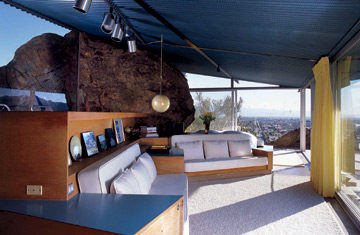
House of Mod New technology and clean design
Perhaps you have never heard of architectural tourism, but an upscale desert enclave in California banks on it. From Feb. 12 to 21, thousands of building and design freaks from as far away as Japan and Australia will descend upon Palm Springs for Modernism Week, modernismweek.com. This 10-day celebration of mid-20th century design runs the gamut from the kitsch (a vintage Airstream trailer show, tours of Elvis' UFO-like honeymoon house) to the academic (lectures on torn-down masterpieces and architects of yesteryear) to the starstruck (movies at Frank Sinatra's former home, wine and cheese at Liz Taylor and Mike Todd's old estate). There's even a mod vintage fashion show.
Albert Frey, Donald Wexler, William F. Cody, E. Stewart Williams. The names may draw blank stares for most people, but in Palm Springs these groundbreaking architects are the hallowed icons of 1950s and '60s design. They are referred to in hushed reverence the way national founders are in other parts of the globe. (Frey, in fact, is receiving his star this year on the Palm Springs walk of fame.) These trailblazers of cool minimalism found the ideal petri dish in midcentury Palm Springs: an anything-goes locale then flush with postwar affluence, forward-thinking Californian optimism and giddy Hollywood clients willing to take design risks.
"Modernist architecture in the desert reflected the interest in new technology after World War II, and materials like glass, steel and concrete block used in construction were integral to the design of a building," explains Sidney Williams, daughter-in-law of E. Stewart Williams and curator of architecture and design at the Palm Springs Art Museum. "The city was an ideal laboratory because of the climate and the use of indoor and outdoor space. And because people had their second homes here, they were more open to being experimental with them."
By the late 1970s, postmodernist architecture, and its plundering of historical trends, overtook the more austere and orthodox midcentury Modernism. But the latter style's popularity evidently shows no signs of losing ground. Established in 2001 as a four-day event, Modernism Week hosted about 20 events last year, and the number will jump to more than 40 this year. Attendance is expected to top 9,000.
Although Modernism's popularity has been a boon to tourist-depleted Palm Springs, the city itself has been slow at times to preserve its own architectural wonders. As recently as 2003, the demolition of the historic (circa 1948) Biltmore Hotel was easily green-lit. The Oasis Hotel, a masterpiece built in 1925 by Lloyd Wright (Frank's son), is now simply an obscure, nonfunctioning Art Deco tower left standing in the city's downtown. More than half a dozen other historic Palm Springs inns have also been razed in recent years.
But thankfully there has also been wonderful preservation. Last year, Palm Springs' Riviera Hotel, psriviera.com, once the retreat of Sinatra's Rat Pack and other stars, reopened after a stunning multimillion-dollar renovation. The Ace Hotel, acehotel.com, an energetically revamped motel, also reopened in 2009 and has become one of Palm Springs' trendier hangouts. If chilling out by its poolside on Sunday afternoons to the sounds of a DJ counts as architectural tourism, you can be sure the pastime will have plenty of takers.
